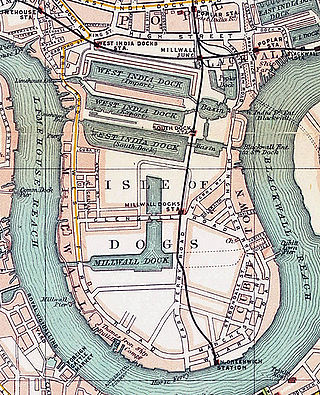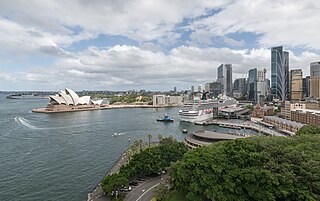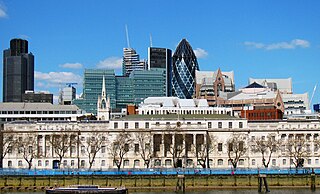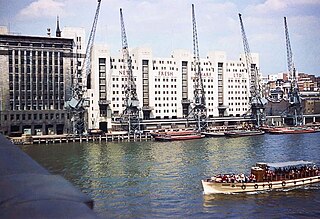
Sugar Quay is a quay alongside the Thames in the City of London, London, England.

Sugar Quay is a quay alongside the Thames in the City of London, London, England.
The quay is located on the North banks of the Thames, between Custom House and the Tower of London. [1] It stands between Lower Thames Street and the Thames, on Water Lane EC3R. [2]
The quay was named after the cane sugar trade, which relies on Caribbean plantations originally worked by African slaves. [3]
As early as 1377, the site was known as Wool Quay and was the location of a custom house used to collect duties due on exported wool. In 1380, John Churchman is recorded as building a custom house on the site, which stood until 1559 when construction of a new custom house was overseen by William Paulet, 1st Marquees of Winchester and Lord High Treasurer. Paulet's structure was destroyed in 1666 in the Great Fire of London.
A new building was designed by Christopher Wren and completed in 1671, being built by the King's Master Mason Joshua Marshall. [4] This structure was damaged by fire in 1715, and was deemed too badly damaged to save. The final iteration of the custom house on the site was built to a design by Thomas Ripley, and remained in use until the early 19th century. At this time, the growth in trade and increase in duties due on goods necessitated the construction of a larger replacement building. Construction of the new Custom House began in October 1813 on a site immediately to the west of Sugar Quay. On 12 February 1814, a fire began in the housekeeper's quarters of Ripley's custom house building, which due to the large volume of spirits, plus smaller amounts of gunpowder, stored on the site resulted in an explosion which destroyed Ripley's custom house at Sugar Quay.
By 1934, the site was referred to alternatively as Wool Quay or Custom House Quay, and was recorded as being in the ownership of Wm. H. Müller and Co., [5] owner of the Batavier Line which operated a steam ship passenger service between Rotterdam and London. Since 1899, the quay had been used as a berth for the ships. [6]
In 1970, architect Terry Farrell designed an office building for British sugar company Tate and Lyle. [7] [8] The development included its own private jetty extending out over the Thames foreshore for outdoor recreational functions.

In May 2014, it was announced that Barratt Developments and CPC Group (owned by Christian Candy) would develop 165 luxury apartments across 11 storeys. [1] The Sugar Quay development contains a mixed use ground floor incorporating residential facilities and amenities, and a waterfront commercial unit. [9] Moreover, the CPC Group is redeveloping 110,000 square feet into a 230,000 square feet of office buildings. [10] Construction involved closure of the Thames Riverside Walk (part of the Thames Path) for some years, which only reopened again in March 2019.

London Docklands is the riverfront and former docks in London. It is located in inner east and southeast London, in the boroughs of Southwark, Tower Hamlets, Lewisham, Newham and Greenwich. The docks were formerly part of the Port of London, at one time the world's largest port. After the docks closed, the area had become derelict and poverty-ridden by the 1980s. The Docklands' regeneration began later that decade; it has been redeveloped principally for commercial and residential use. The name "London Docklands" was used for the first time in a government report on redevelopment plans in 1971 and has since been almost universally adopted. The redevelopment created wealth, but also led to some conflict between the new and old communities in the area.

London Bridge refers to several historic crossings that have spanned the River Thames between the City of London and Southwark, in central London since Roman times. The current crossing, which opened to traffic in 1973, is a box girder bridge built from concrete and steel. It replaced a 19th-century stone-arched bridge, which in turn superseded a 600-year-old stone-built medieval structure. In addition to the roadway, for much of its history, the broad medieval bridge supported an extensive built up area of homes and businesses part of the City's Bridge ward and its southern end in Southwark was guarded by a large stone City gateway. The medieval bridge was preceded by a succession of timber bridges, the first of which was built by the Roman founders of London (Londinium) around 50 AD.

Silvertown is a district in the London Borough of Newham, in east London, England. It lies on the north bank of the Thames and was historically part of the parishes of West Ham and East Ham, hundred of Becontree, and the historic county of Essex. Since 1965, Silvertown has been part of the London Borough of Newham, a local government district of Greater London. It forms part of the London E16 postcode district along with Canning Town and Custom House.

The West India Docks are a series of three docks, quaysides, and warehouses built to import goods from, and export goods and occasionally passengers to the British West Indies. Located on the Isle of Dogs in London, the first dock opened in 1802. Following their commercial closure in 1980, the Canary Wharf development was built around the wet docks by narrowing some of their broadest tracts.

Harbourfront is a neighbourhood on the northern shore of Lake Ontario within the downtown core of the city of Toronto, Ontario, Canada. Part of the Toronto waterfront, Harbourfront extends from Bathurst Street in the west, along Queens Quay, with its ill-defined eastern boundary being either Yonge Street or York Street. Its northern boundary is the Gardiner Expressway. Much of the district was former water lots filled in during the early 1900s to create a larger harbour district. After shipping patterns changed and the use of the Toronto harbour declined, the area was converted from industrial uses to a mixed-use district that is mostly residential and leisure.

Circular Quay is a harbour, former working port and now international passenger shipping terminal, public piazza and tourism precinct, heritage area, and transport node located in Sydney, New South Wales, Australia on the northern edge of the Sydney central business district on Sydney Cove, between Bennelong Point and The Rocks. It is part of the local government area of the City of Sydney.

The Lower Lea Valley is the southern end of the Lea Valley which surrounds the River Lea in eastern Greater London. It is part of the Thames Gateway redevelopment area and was the location of the 2012 Summer Olympics.

The Bennelong Apartments is a residential apartment building and multi-use complex on the east side of Sydney's Circular Quay. The buildings were designed by Andrew Andersons and PTW Architects, and completed in 1998.

St George Wharf is a riverside development in Vauxhall, Lambeth, London, England, located on the southern bank of the River Thames beside Vauxhall Bridge. Vauxhall Pier is a calling point for Uber Boat by Thames Clippers riverboats RB1, RB2 and RB6 services.

The Batavier Line was a packet service between Rotterdam and London from 1830 until the 1960s. The line was established by the Nederlandsche Stoomboot Maatschappij.

Enderby's Wharf is a wharf and industrial site on the south bank of the Thames in Greenwich, London, associated with Telcon and other companies. It has a history of more than 150 years of production of submarine communication cables and associated equipment, and is one of the most important sites in the history of submarine communications.

The Custom House, on the north bank of the Thames in the City of London, is a building which was formerly used for the collection of customs duties. A custom house has been present in the area since the 14th century, and a building on its current site has been rebuilt on a number of occasions. Today the Custom House is used by His Majesty's Revenue and Customs. The address is 20 Lower Thames Street, EC3. Custom House is neighboured on the waterfront by Sugar Quay to the east and Old Billingsgate Market to the west.

Wardian London is an ultra-luxury residential complex located in the centre of Canary Wharf’s financial district from Eco World-Ballymore and designed by architect firm Glenn Howells. The scheme consists of two skyscrapers that completed in 2020, is one of the tallest residential developments in London and the United Kingdom.

Fresh Wharf was a wharf located in the City of London close to London Bridge, on the north bank of the River Thames. The site was used as a quay in Roman times and later as an unloading place for Anglo-Saxon boats. A wharf was constructed there at some point in the medieval period and appears to have acquired its name from its customary usage as a landing place for fresh fish. In the 16th century, Fresh Wharf was made a "Legal Quay" authorised for the import of certain goods during the reign of Queen Elizabeth I of England. It expanded as London's river-borne trade grew in the 18th and 19th centuries, with large warehouses being established immediately behind the wharf. In the 20th century, the wharf's owners took over the adjoining wharves immediately upstream and downstream, built a new ten-storey warehouse and renamed the site New Fresh Wharf. By the end of the 1960s, however, London's docks had fallen into disuse with the advent of containerization, for which they were not suited, and the wharf was closed down in 1970. An office block was built on the site of the warehouse in 1977 and the former quayside is now part of a public footpath along the Thames.

The Legal Quays of England were created by the Act of Frauds, an Act of Parliament enacted in 1559 during the reign of Elizabeth I of England. It established new rules for customs in England in order to boost the Crown's finances. One of its most important provisions was the establishment of a rule that it was illegal to land or load goods anywhere other than authorised Legal Quays in London and other ports, under the supervision of customs officers. The legislation also set out which towns were authorised to act as ports.

South Quay Plaza is a residential-led development under construction in Canary Wharf on the Isle of Dogs, London, England, within the borough of Tower Hamlets. It is being developed by Berkeley Group Holdings and was designed by architect Foster + Partners. The site of the development lies to the immediate north of Marsh Wall and to the immediate south of the financial district Canary Wharf. The entire development is scheduled for completion in 2028.
54 Marsh Wall is a planned residential/retail skyscraper in the Isle of Dogs, London. The building was approved by Tower Hamlets on 19 January 2017. At 140 meters high and containing 216 residential units, the tower will be among a number of similar residential skyscrapers under construction in the Isle of Dogs, including South Quay Plaza and the Landmark Pinnacle. An earlier proposal, submitted in 2014, envisioned 240 residential units involving two twin towers at 39 and 29 stories. The structure is due to be completed in 2024.

Old Woolwich or Woolwich Central Riverside is an area along the Thames in Woolwich, South East London. It is the oldest inhabited part of Woolwich, going back to an Anglo-Saxon riverside settlement. When the demographic centre of Woolwich shifted south in the 1800s, the area became a Victorian slum. Most of Old Woolwich was cleared in the 20th and early 21st centuries to make way for industrial, infrastructural and other large-scale developments. Although most of the earlier buildings have been demolished, the area has retained some interesting architecture, including the Georgian parish church, the Edwardian foot tunnel rotunda and two cinemas of the 1930s.

The Virginia Quay Settlers Monument is a public monument in Tower Hamlets, London, to the first settlers of the Colony of Virginia who departed from here in 1606. The monument has its origins in a plaque erected on the Brunswick Dock master's house in 1928. The house was badly damaged by bombing during the Second World War and in 1951 the plaque was incorporated into a monument erected during development of the site into the Brunswick Wharf Power Station. The monument was designed by Harold Brown and consisted of rough-hewn granite blocks from the walls of the West India Docks surmounted by a bronze sculpture of a mermaid. The mermaid was later stolen. The monument was refurbished by Barratt Homes during redevelopment in 1999. A polished granite plinth was added and the mermaid replaced by a mariner's astrolabe sculpted by Wendy Taylor. The monument is currently located on the riverside facing the Millennium Dome.